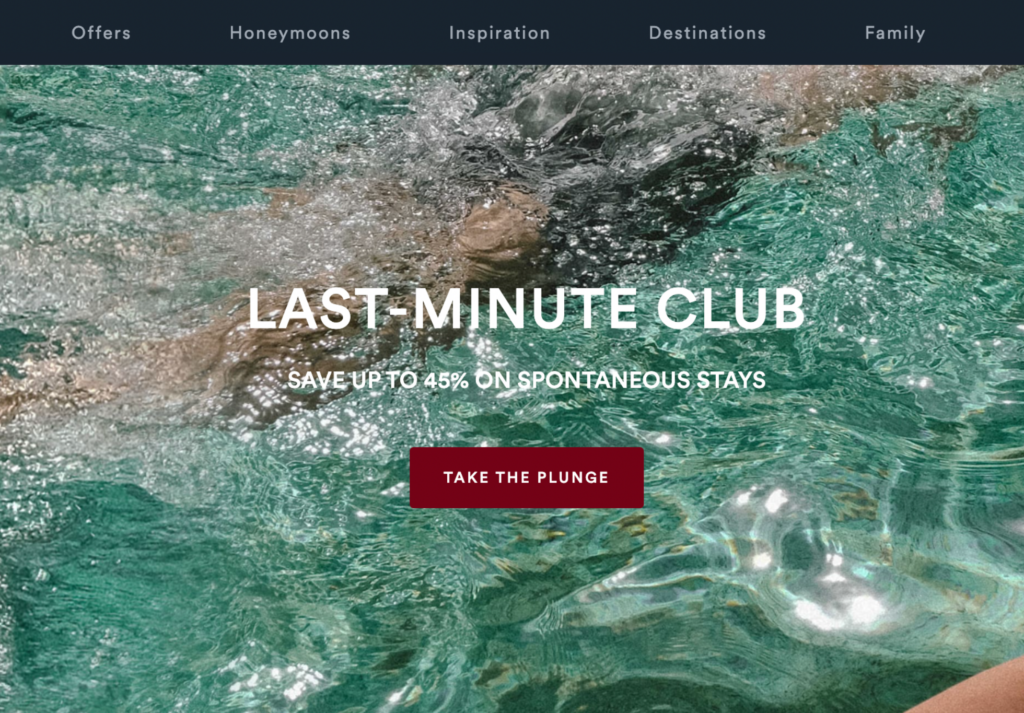Have you ever found yourself captivated by a travel advert, blog post or social media account that seemed to transport you to a far-flung destination, even if you were just sitting at home? Chances are, what drew you in was not just the beautiful images or enticing offers but the compelling story woven into the marketing content. In the world of travel marketing, storytelling is an extremely powerful (and in my opinion, non-negotiable) tool that can inspire wanderlust, create emotional connections with travellers, and ultimately drive those bookings. For my first blog post (eek!), I want to explore the magic of telling stories in travel marketing, with a close look at the exceptional work of luxury travel club, Mr & Mrs Smith.
Why storytelling matters in travel marketing
On the incredibly rare off chance that you’re not a seasoned holiday-maker, the travel industry thrives on experiences and emotions. When people plan their trips, they’re not merely seeking destinations; they’re seeking stories to fill their mind, body and soul. They want to imagine themselves on a grand adventure, exploring new cultures, and making memories that last a lifetime. This is where storytelling comes into play.
Storytelling in travel marketing goes beyond highlighting the features of a destination or a hotel. It’s about painting a vivid picture of the entire experience, and taking the audience on the whole journey. Whether it’s a romantic getaway to a secluded island or an epic road trip through the mountains, storytelling can make travellers feel like they’re already there. It taps into their dreams and aspirations.

The 5 key elements of compelling travel stories
Creating compelling travel stories involves several key elements:
- Setting the Scene – Think of your words as a magic carpet. Your job is to whisk your audience away from their everyday lives and position them right into the heart of your destination or hotel. Describe the beauty, culture, and uniqueness with such vividness that they can almost taste the salty breeze and hear the hum of the bustling markets.
- Introduce Relatable Characters – In the world of travel, everyone is a protagonist, the star of their own epic adventure. Picture the intrepid solo traveller, a backpack-clad explorer with a heart full of wanderlust, ready to embrace the unknown. By introducing a relatable character in your storytelling, giving them quirks, aspirations and personalities your audience can identify with, they become the adventure, and your audience will want to follow in their footsteps.
- Create a Sense of Adventure – It’s not just about scaling mountains or bungee jumping off cliffs (although if anyone has any recommendations, hook me up!). It’s about those heart-pounding moments that make you feel alive. It’s the sizzle of street food on a bustling night market in Bangkok, the adrenaline rush of white-water rafting through untamed rapids, or the goosebumps that rise when you step outside onto your private overwater villa in the Maldives.
- Describe What’s at Jeopardy – Don’t worry, I’m not suggesting you tell your audience all the cons your 5 star resort has (if any), but any compelling story comes with a sense of tension and something at stake. By creating a sense of risk (e.g. what will they miss out on by not booking with you) you’ll create an element of urgency and emotional engagement for your audience. In travel marketing, this element is crucial because it helps travellers connect with the experience on a deeper level.
- Driving Towards an Endpoint – Every story has a beginning, middle and end. Crafting a narrative arc with a clear endpoint is essential for guiding your audience through the journey and providing a satisfying resolution. Having a destination, a goal, or an endpoint in your storytelling serves several purposes. It keeps your readers engaged, eager to see how the journey will conclude. It helps structure your content, ensuring a logical flow that’s easy to follow. It also creates a sense of accomplishment and closure when the story reaches its endpoint, leaving readers satisfied and fulfilled. Whether it’s showcasing the grand finale of a luxury resort stay, the breathtaking view from a mountaintop, or the magical moment of a cultural festival, having a destination in mind helps travellers envision themselves reaching that point, making it more likely they’ll take the desired action, such as booking a trip.

One of my absolute favourite luxury travel brands, Mr & Mrs Smith, known for curating boutique hotels and experiences, excels in incorporating these elements into their marketing mix. I was lucky enough to attend a keynote with their founder and CEO, Tamara Lohan, who perfectly narrated the businesses conception through her very own true story. It was witty, entertaining, and at times even sad, and it had all the components to keep me hooked throughout the 45 minute session. Let’s take a closer look at their approach.
What travel brands can learn from Mr & Mrs Smith
Mr & Mrs Smith have mastered the art of storytelling in travel marketing. As I sat in the very last row at their keynote session during the Technology for Marketing event (I like to take in everyone’s perspective by positioning myself right at the back), I was instantly drawn in to Tamara’s warm charisma.
To tell her story in ‘short’ – 20 years ago she fell in love with a holiday romance whom she shared a strong love for travelling and holidays. All their friends would come to them for holiday advice and they’d spend hours scouring travel magazines and brochures (because that’s all there was back then). They decided they wanted to go on a wonderful British getaway and settled on somewhere based on its beautiful imagery. I almost snorted out loud when she described how when she and her new-love first arrived, they were immediately whisked into a room and weighed. She described the smell of catering and the disappointment at finding a trouser press propped up against the bedroom wall. She shared how they’d agreed to buy the most expensive bottle of wine to make up for it, but when entering the restaurant they were greeted by a calorie-controlled menu, no alcohol and, to top it all off, everyone was still in their gowns. I could literally picture her in her favourite Manolo Blahnik’s excited by the idea of sitting down for a romantic meal with her lover. So they decided to call it quits and head to the nearest local pub, There, as they finally sipped their Pinot Noir, they conceived the idea of Mr & Mrs Smith, originally a book that curated the very best hotels in the world. They wanted to know the important details, what the Egyptian-cotton count was, the barman’s favourite cocktail, and which really cared about how their customers felt.
Tamara’s story sold me as it had a strong narrative throughout. She set the scene, the introduced relatable characters (her and her lover), she created a sense of adventure and jeopardy, and she concluded with an uplifting and inspiring end.

But their storytelling doesn’t end with how they came to be. Every one of their carefully curated hotels, every piece of their drool-worthy content and everyone of their bespoke campaigns and partnerships tells an aspirational, yet relatable tale. They tap into consumer behaviour so, so well. Take the ‘LAST-MINUTE CLUB‘ for example (pictured above), I don’t know anyone that wouldn’t want to be part of that club. Or the way they ask empathetic questions like “where on earth should I go?” and “can we help you find ‘the one’?“
Does storytelling like this actually work in travel marketing? Absolutely.
Analysing the impact
Mr & Mrs Smith’s storytelling efforts have yielded fabulous results. Their campaigns have seen increased engagement, longer time spent on their website, and most importantly, higher bookings. Why? Because they’ve tapped into the emotional core of travellers.
When people read or watch their content, they don’t just see a hotel or a destination; they see themselves in the story. They feel the anticipation of the journey, the thrill of the adventure, and the warmth of the memories they’ll create. It’s not just about booking a room; it’s about booking an experience.
Practical tips for effective storytelling
Now that we’ve seen the power of storytelling through the lens of Mr & Mrs Smith, how can you (the super badass travel industry professional) harness this power?
- Authenticity Is Key – Your stories must align with your brand values and the actual experiences travellers can expect. Authenticity builds trust.
- Choose the Right Platforms – Share your stories on the platforms where your audience hangs out. This might include your website, social media channels, email marketing, and travel forums.
- Use Multimedia – Engage your audience with visually appealing content. High-quality images, videos, and interactive elements can enhance your storytelling.
- Consistency Matters – Maintain a consistent storytelling style across your marketing efforts. This helps in building a recognisable brand narrative.

In the ever-evolving world of travel, storytelling remains a timeless and powerful tool. It can transport your audience to far-flung lands, evoke emotions, and drive those all-important bookings. As demonstrated by Mr & Mrs Smith, the key lies in creating immersive stories that resonate with travellers.
So, if you’re in the travel industry, it’s time to start crafting your narratives, sharing your adventures, and inviting your audience to join in the journey. Your stories have the power to inspire wanderlust and turn dreamers into travellers.
Follow me on Instagram @thetravelsocialagency for quick tips and takeaways for your travel business to start implementing today.